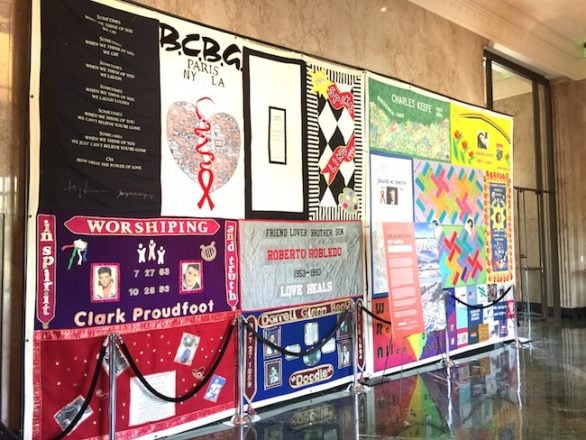
These panels from The NAMES Project AIDS Memorial Quilt are on display in Beverly Hills thru Sunday. Photo: Courtesy of The Advocate.
BEVERLY HILLS — In June 1987, a group of strangers in San Francisco wanted to document the lives of their loved ones who had died of AIDS-related complications and whom they feared history would neglect.
The group was lead by the indefatigable gay rights activist Cleve Jones, who conceived the idea of a quilt as a memorial to the men who had died. This poignant symbol – The NAMES Project AIDS Memorial Quilt – would also help people understand the devastating impact of the disease.
The quilt panels are individually hand sewn, and each one contains specific details about the person and their life, making it a personal tribute.
In connection with World AIDS Day, which was December 1, three quilt panels are on display in Beverly Hills at The Wallis Annenberg Center for the Performing Arts and The Beverly Hills Public Library thru Sunday.
Weighing more than 54 tons, the AIDS Memorial Quilt is the world’s largest piece of community folk art. It also contains more than 48,000 individual 3-by-6 foot memorial panels.
The Advocate and real estate agent Michael J. Libow were the hosts who brought the quilt panels to Beverly Hills.
The quilt connects people: “It’s a place to grieve and honor the lives of people we love and have lost,” said Julie Rhoad, president and CEO of the NAMES Project. “People from all walks of life, mothers, fathers, brothers, sisters, straight people are connected to the quilt. Once you make a panel, you are part of the community.”
The quilt as a weapon: “Cleve saw the quilt as a weapon that fought bigotry,” Rhoad said. “In the 1980s, people were condemning the ‘homosexual lifestyle’ on Congressional floors. Hate and stigma around this disease and the people perceived to have it was cruel and intolerable.People talked about the people who died as statistics. Cleve saw that the bigotry and homophobia that existed perpetuated the spread of the disease and the horrible time we were in.
“It was compelling that you could use cultural materials to teach people and help shape their views,” she said. “It’s a weapon against intolerance made from fabric. We’re fighting a battle with needle and thread. Not all battles are fought with a sword.”
The quilt as a teaching tool: “The quilt helps us see the humanity and the connection with humanity in each panel,” Rhoad said. “We are connected to one another. The quilt helps people transform their ideas on stigma and shame into understanding.”
